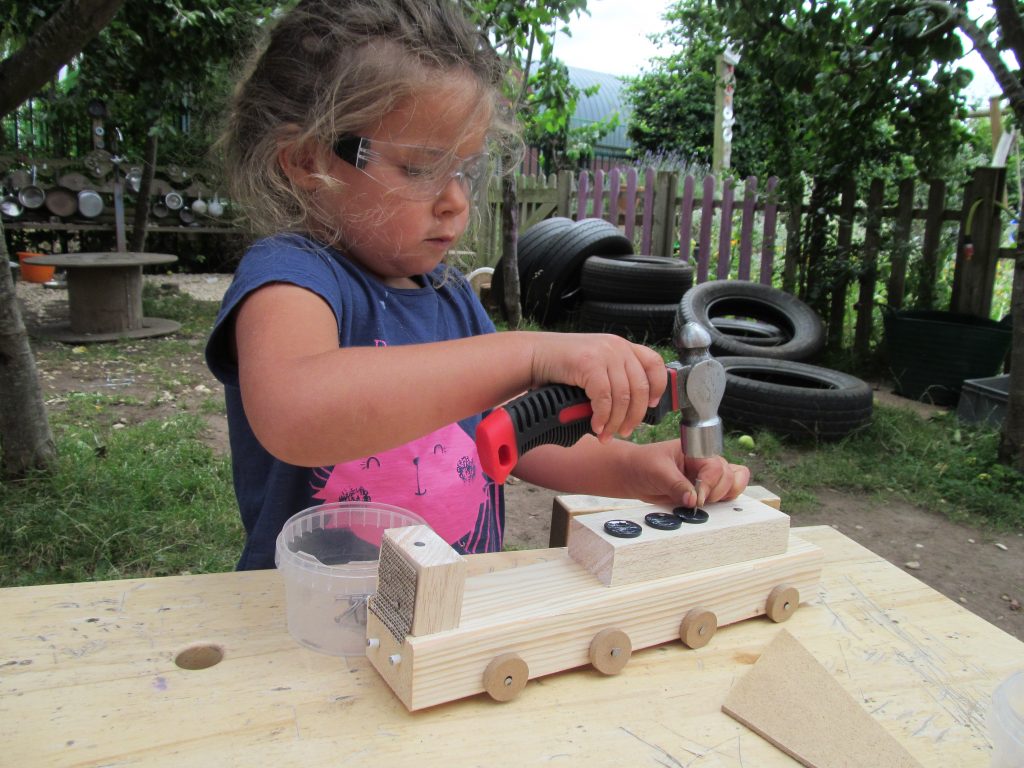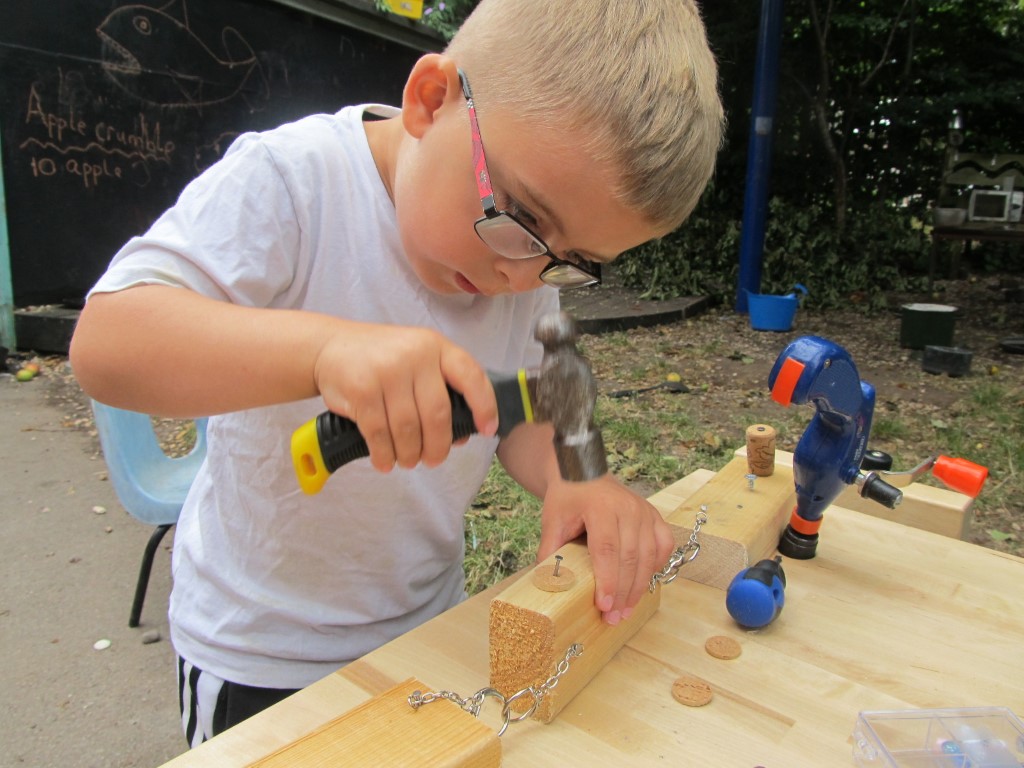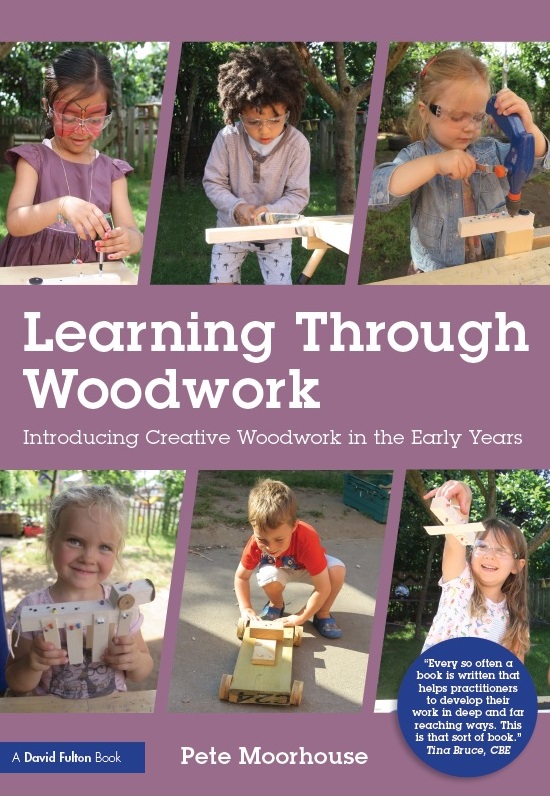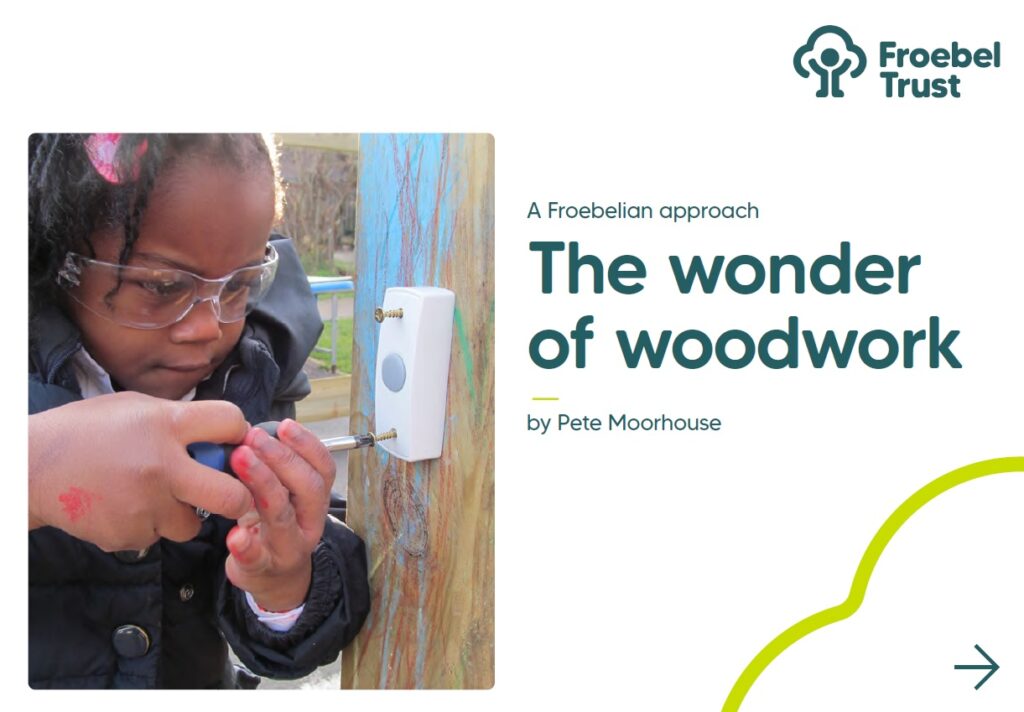– Welcome to the home of Woodwork in Early Childhood Education and beyond…

The wonder of woodwork….
Woodwork is a wonderful way to enhance provision in early childhood settings and primary schools. It’s a truly holistic, with potential to embrace all areas of learning. There is quite a lot to know in order to safely introduce woodwork and embed it successfully within provision. This page contains links to all the information and training options to get you started and advice on how to make the most of your provision.
At the workbench children are learning skills that will empower them to shape their world.
Pete Moorhouse 2021
It’s learning through doing.
New: In-person woodwork CPD on June 20 LONDON
Woodwork HUB: Below you can follow the links to find information about:
CPD/ INSET woodwork training delivered in settings
Training is delivered both within the UK and internationally
In-depth online CPD woodwork training course
A course of 8 video tutorials and a comprehensive set of 18 handouts
Conference keynote presentations about woodwork in early years
Conference keynote presentations and workshops are available within the UK and internationally
Free woodwork resources
Everything from the most appropriate equipment, recommended suppliers to health and safety guidance
General information about woodwork in early childhood education
Read some of my thoughts below…
Research findings – The Big Bang Research Project
Read the evidence for woodwork and if you already provide woodwork please complete the research survey
The Big Bang Project – campaign advocating for woodwork provision to be available to all children
Initiative advocating for woodwork provision to be available to all children
Books and articles about woodwork
With a selection available to download
The woodwork Facebook group
Open to all. Do share and ask questions. Learning through making.
The Big Bang Woodwork Award
In recognition of exceptional practice
Woodwork in primary schools
For information on CPD for primary schools – coming soon
Suppliers of tools, workbenches and wood
For information on CPD for primary schools – coming soon
The wonder of woodwork
Woodwork is active learning at it’s best
Professor Tina Bruce CBE 2004:109
Below are some of my thoughts about the value woodwork in early childhood education….

A profound experience…
The experiential nature of woodwork involves the ‘whole’ child developing core dispositions and especially nurturing wellbeing, self-confidence, and a sense of agency – that ‘can-do’ spirit that develops as ideas are put into action.
Moorhouse 2021:3
A special magic…
These are exciting times. In recent years there has been a surge of interest in woodworking in early childhood education around the world. In some cases this will be settings starting from scratch, in others, it’s a case of dusting down the workbench and digging out the tools after many years of neglect.
This is very welcome as the benefits of woodwork for children’s learning and development run deep across all areas of learning. Teachers who provide woodwork regularly observe exceptional levels of sustained engagement, with deep focus, concentration and perseverance with challenging tasks – especially with complex problem solving. It is not unusual for children to spend all morning at the woodwork bench. Woodwork really engages hands, minds and hearts.
The rise in the popularity of woodwork not surprising given the levels of children’s enjoyment and the fact that it provides such a profound learning experience. The renewed interest is also fuelled by several factors. In part it is a reaction to children’s digital immersion, where children have often learnt to swipe before they can walk, with woodwork offering an antidote by providing rich experiential hands on learning. We are also seeing a resurgence of ‘making’ in society in general with a renewed interest in craft and upcycling, perhaps a reaction to our highly commercialised world and the need for more sustainable practices. With this increasing focus on sustainability, woodwork gives children experience of working with a natural material, as well as reusing and repurposing materials. The experience of making and repairing, counters the prevalent culture of consuming and disposing. In addition the creative and critical thinking skills developed will be increasingly invaluable to seek solutions to the challenges we all face.
Globally we have also seen shifting attitudes, moving away from risk aversion and we are seeing positive guidance from health and safety bodies, education departments and inspectorates taking a more balanced attitude towards risk, understanding the importance of children learning how to make decisions and judgements for themselves.

The value of woodwork….
Why Woodwork in Early Years Education?
There is something really special about woodwork. It is so different from other activities. The smell and feel of wood, using real tools, working with a natural material, the sounds of hammering and sawing, hands and minds working together to express their imagination and to solve problems, the use of strength and coordination: all go together to captivate young children’s interest.
We observe children working with their hands, tinkering, constructing models, and working on projects, but in fact the real transformation is inside the child – personal development is at the heart of woodwork.
Pete Moorhouse 2021
Woodwork is a powerful medium for building self-esteem and confidence. Children feel empowered and valued by being trusted as they take responsibility to work with real tools. They accomplish tasks that they initially perceive to be difficult and problem-solve to resolve challenging tasks. They show great satisfaction in their mastery of new skills and take immense pride in their creations. This sense of empowerment and achievement provides a visible boost to self-esteem and self-confidence. Children have a natural desire to construct and build. This imparts a ‘can-do’ attitude and imbues children with a strong sense of agency – a belief they can shape their world.
When we analyse a woodworking session it is extraordinary to see just how much learning is involved. It’s truly holistic encompassing all areas of learning and development and invites connections between different aspects of learning. In this sense woodwork really can be central to curriculum. It incorporates mathematical thinking, scientific investigation, developing knowledge of technology, a deepening understanding of the world, as well as physical development and coordination, communication and language, and personal and social development. This is evidenced by research from ‘The Big Bang Research Project’ The interim research findings are now available – see the link at the top of this page.
Woodwork provides another media through which children can express themselves. Creative and critical thinking skills are central both in terms of imagination and problem-solving as children make choices, find solutions, learn through trial and error and reflect on their work. Forms of life, beauty and knowledge are all interwoven, as children apply previous experiences and their emerging knowledge of tools to create new forms and make meaning.
Children are particularly drawn in as they explore possibilities, rise to challenges and find solutions. Woodwork is really unrivalled in terms of providing children with problem solving opportunities and challenge. With woodwork children can develop their learning at their own pace and find their own challenges. Once they have mastered basic skills, they move into open-ended exploration – initially tinkering, exploring possibilities and then starting to make unique creations.
Woodwork is a certainly a popular activity and incorporates so much learning. It would be wonderful for all children to have this opportunity to flourish at the woodwork bench.
Woodwork is a bit like a magic carpet of skills which last a lifetime. It involves curiosity, creativity and a
Solly 2018
rich opportunity to engage with process based learning leading to deep involvement and satisfaction.
Books and articles:
My comprehensive book; Learning through Woodwork: Introducing Creative woodwork in the Early Years – Available from Routledge or Amazon and other bookshops – “Every so often a book is written that helps practitioners to develop their work in deep and far reaching ways. This is that sort of book.” Tina Bruce CBE For more information on the new book
The Wonder of Woodwork – A Froebelian Approach – Pete Moorhouse The Froebel Trust Pamphlet 2021
Gwaith coed mewn addysg plentyndod cynnar 2019 Pete Moorhouse Mudiad Meithrin, Wales
Holzarbeiten im Vorschulalter 2017 Pete Moorhouse Community Playthings Deutschland GmbH
Pete Moorhouse Woodwork in the early years Pete Moorhouse Community Playthings 2015
Woodwork in Early Years Education Pete Moorhouse Independent Publishers Unavailable/ out of print 2012
Journals:
The wonder of woodwork Pete Moorhouse NSEAD National Society for Education in Art and Design 2018 Issue 23
Holzarbeit – by Pete Moorhouse – Kinder – Berlin, Germany 2019
Woodwork – The Space Childspace Early Childhood Institute, New Zealand 2019
Woodwork in Early Childhood Education Pete Moorhouse Tomorrow’s Child Montessori Foundation USA 2018 Vol 26 No1
Tooled up! Pete Moorhouse Nursery World April 2018
The art of woodwork in early years education 2018 Early Childhood ecArtnz Aotearoa New Zealand
Mathematical development: Woodwork providing skills for life Pete Moorhouse Small talk Wales Issue 129 2018
The wonderful rise of woodwork in Early Years Parenta Magazine 2017 Issues 38 and 39
Woodwork in the Early Years Pete Moorhouse Small talk- Wales PPA 2015
Wonderful Woodwork Pete Moorhouse Early Years Educator Volume – Vol 13 No. 11 March 2012
Introducing young children to working with wood Pete Moorhouse Early Years Update – Issue 97 April 2012
All about woodwork Nursery World Pete Moorhouse– 14-27 May 2012
Woodworking wonders Pete Moorhouse Early Years Educator Volume 13 No11 March 2012



